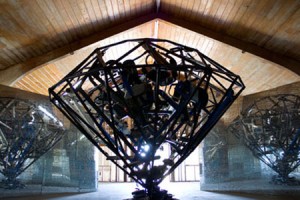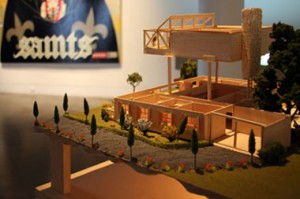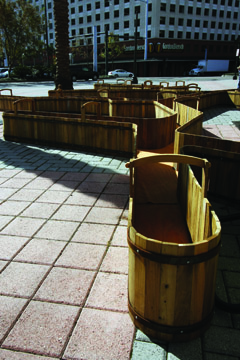« Features
Prospect.1 in New Orleans

Nari Ward. Diamond Gym: Action Network, installed at Battle Ground Baptist Church as part of Prospect.1 New Orleans. Photo credit: Jake Fontenot
By Natalie Sciortino-Rinehart
One of the primary missions of Prospect.1 has been to help in the recovery of New Orleans, especially its cultural economy, through staging the largest biennials of contemporary art ever organized in the United States. With over eighty artists and more than two dozen venues, this historic biennial brought together key international artists like Cai Guo Qiang, William Kentridge, Janine Antoni, Sanford Biggers, Julie Mehretu, and Nari Ward. Many of the works, like Mark Bradford’s large ark, were site specific while others, like Qiang’s Fireworks, wonderfully recontextualized past favorites. Among the readily apparent successes of Prospect.1, are the overwhelming responses of the local arts scene through numerous satellite exhibitions that attest to the stamina and drive of artists from the city and surrounding region. Instead of confining the shows to a singular arts district or institutional setting, curator Dan Cameron strategically selected a range of venues all over the city - where visitors receive an important and more informed exposure to New Orleans from venues in the Lower Ninth Ward to the exciting emerging arts scene along the St. Claude corridor. The venues themselves offer an interesting connection and glimpse into the heart and history of their communities as well. With the city still reeling from the epically-tragic events of Katrina, many artists chose to address this complex reality through their work in direct and indirect ways.
Many works throughout this expansive exhibition readily stand out, such as William Kentridge’s work at the African American Museum situated in the historic Treme neighborhood on the site of a former plantation. What Will Come (has already come) is Kentridge’s brilliantly-executed stop-animation housed in small cottage behind the museum. The animation is projected onto a circular table, with a cylindrical mirror in the middle where the projected images are perfectly reflected, correcting the distortion and direction from the table. Through a series of charcoal drawings set in motion, Kentridge’s work embodies broader ideas of human history and the causalities of progress. When walking into the darkened room, the artists spinning animation piece emanates from the table and reflective core like a crystal ball foretelling a frightful future too late.
Another installation that explores the darker sides of human existence is the socially-engaged work of Jackie Sumell. In The House that Herman Built, Sumell follows the controversial story of a wrongly-imprisoned Black Panther party member, Herman Wallace. The artist began corresponding with Wallace, who is currently serving a life sentence at the Louisiana State Penitentiary at Angola, where he has been in solitary confinement. When Sumell asked him what he dreams of during his confinement, his reply and ongoing exchanges revealed that it was a dream house complete with a pool and underground bunker. Based on his descriptions, Sumell created a floor plan and model for Herman’s house. For Prospect.1, Sumell presented an exhibition of drawings, letters, blueprints, a virtual tour of the house and a wood recreation of the solitary confinement cell where Wallace has spent the last thirty-six years of his life. While this unlikely collaboration reveals the plight of the unjustly imprisoned, it gives another voice to a cause that may otherwise go unnoticed.
In a region historically plagued by racial tension and prejudice, Sanford Biggers’ large-scale Blossom sculpture on the second floor landing at the old United States mint, serves as a symbol for potential healing. A grand player piano is lodged in the middle of a large tree with sprawling branches. The piano continues to play Billie Holiday’s Strange Fruit - whose lyrics condemn racial injustice and lynching. Instead of the grievous fruit of Holiday’s tune, Biggers’ musical Blossom pays homage to the hard-fought civil rights struggle through utilizing the provocative nature of art as an aesthetic and sound sensory experience.
New Orleans artist, Willie Birch, offers a first-hand look at many tough realities still faced by the African American community in his neighborhood. Each work on paper is completed in charcoal and white paint, depicting snapshot-like scenes from around the artist’s home. The large works on paper are hung together in different groupings that seem to tell a story. In works like Sweeping, Scrubbing, Washing, Healing, two men pour a bucket of water over the street where a murder apparently took place. Birch beautifully and respectfully captures this moment of tragic aftermath. In his richly-layered style, the artist documents an array of churches, homes, and street corners in various stages of rebuilding. Though his art, Birch presents the places and everyday people that bind his community together.

Jackie Sumell & Herman Wallace. The House that Herman Built, Scaled Balsa Wood Model, 2007. Photo Credit: John d'Addario.
One particularly poetic piece that serves as one of the most successful in situ artworks is Nari Ward’s Diamond Gym at Battleground Baptist Church in the Lower Ninth Ward. Angled mirrored walls face an enormous metal gemstone-shaped framework housing a tangled conglomeration of used exercise equipment. Sound recordings of great civil rights speeches play in the background mixing with hypnotic Buddhist chants. The overall effect is completely enrapturing. The central diamond-shaped gym becomes a powerful icon for the struggle forged by this community both before and after the hurricane.
Other emblematic works are found throughout Prospect.1. In Tabula Rasa at Colton School, (an abandoned high school turned community artist space) Jose Damasceno carefully places white pieces of chalk to form a large outline of a calculator on a classroom floor, creating a simple yet dynamic piece. At the Tekrema Center for the Arts, Sebastian Preece’s Tanto Tiempo installation consists of unearthed slabs from flooded homes that give a poignantly surreal Pompeian quality to these former foundations. Alexandre Arrechea (formerly of Los Carpinteros) also constructs a simple structure full of conceptual implications with his Mississippi Bucket sculpture standing outside of the Plaza of Good Fortune near the Mississippi River. A sprawling wooden bucket branches off into the shape of the Mississippi Delta, capturing one of the most vulnerable and powerful elements of nature. Arrechea captures the precarious irony of the river that is an essential sustaining force capable of catastrophic flooding.
One of the most inspiring aspects of the biennial was the insurgence of local satellite exhibitions that emerged from the powerfully-packed exhibitions at Universal Furniture and Colton School to the multiple Arts Council of New Orleans public arts projects all over the city. Numerous artist-run galleries and projects like Good Children Gallery, the Front, Antenna, Aorta Projects and the Coup’ de Art Consortium. Through resurrecting unused or dilapidated spaces around the city, these organizations and many others like them, have proved the potentially transformative power of art - something desperately needed within a city with such a rich cultural legacy that must continue. Overall, for New Orleans, Prospect.1 represents the commitment and belief in sustainability of the arts community here - one of the most important elements to emerge from this inaugural biennial.
Natalie Sciortino-Rinehart is an artist and writer living and working in her hometown of New Orleans. She has had works published in the New Orleans Art Review, ArtForum online, and Art Voices magazine. She holds an MFA from the University of New Orleans.



































